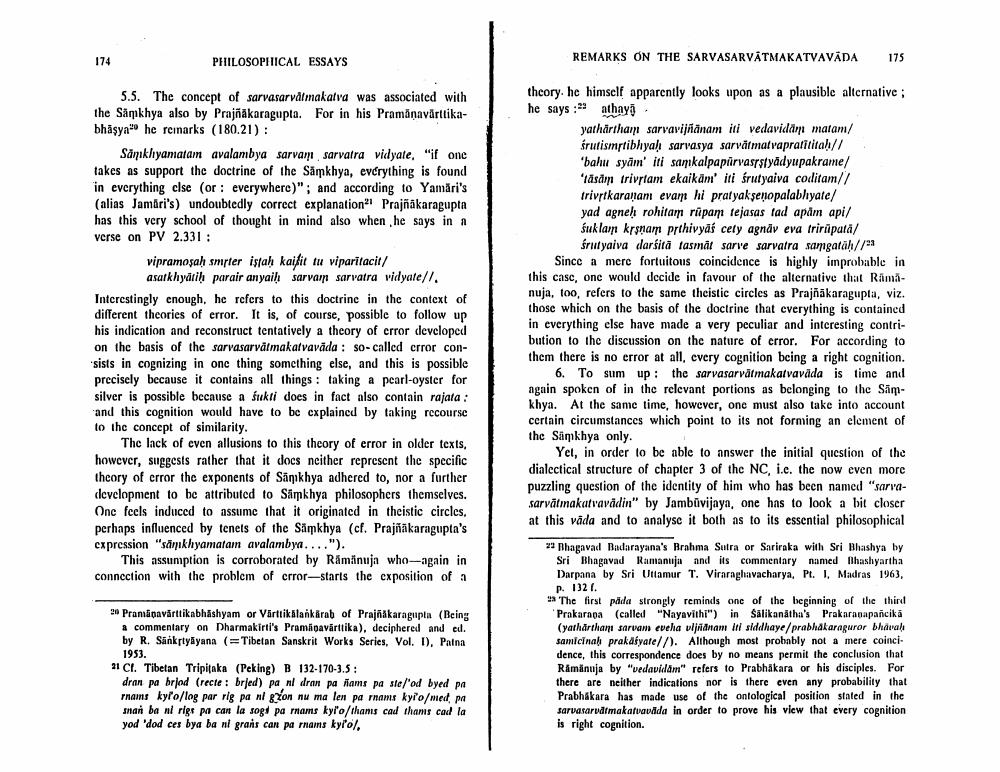Book Title: Remarks On Sarvasarvatmakatvavada Author(s): A Wezler Publisher: A Wezler View full book textPage 5
________________ 174 PHILOSOPHICAL ESSAYS REMARKS ON THE SARVASARVĀTMAKATVAVĀDA 175 5.5. The concept of sarvasarvatmakatva was associated with the Sankhya also by Prajñākaragupta. For in his Pramanavarttikabhāşya he reinarks (180.21): Sänklyamatam avalambya sarvam sarvatra vidyate. "if one takes as support the doctrine of the Sankhya, everything is found in everything else (or : everywhere)"; and according to Yamari's (alias Jamari's) undoubtedly correct explanation Prajñākaragupta has this very school of thought in mind also when he says in a verse on PV 2.331 : vipramosah smrter istah kaifit tu viparitacit/ asarkhydrih parair anyaih sarvan sarvatra vidyate//. Interestingly cnough, he refers to this doctrine in the context of different theories of error. It is, of course, possible to follow up his indication and reconstruct tentatively a theory of crror developed on the basis of the sarvasarvatmakarvavada: so-called crror consists in cognizing in one thing something else, and this is possible precisely because it contains all things : taking a pearl-oyster for silver is possible because a fukti does in fact also contain rajata : and this cognition would have to be explained by taking recourse to the concept of similarity. The lack of even allusions to this theory of error in older texts, however, suggests rather that it does neither represent the specific theory of crror the exponents of Sāņikhya adhered to, nor a further development to be attributed to Samkhya philosophers themselves. Onc fccls induced to assume that it originated in theistic circles, perhaps influenced by tenets of the Samkhya (cf. Prajñākaragupta's expression "sänkhyamatam avalambya...."). This assumption is corroborated by Ramanuja who-again in connection with the problem of crror-starts the exposition of a theory. he himself apparently looks upon as a plausible alternative ; he says athayo yathärtham sarvavijñānam iti vedavidam matam/ śrutismptibhyah sarvasya sarvatmat vapratititah// 'bahu syām' iti sankalpapirvaststyādyupakrame/ 'lasam trivslam ekaikām' iti śrutyaiva coditam// trivrtkaranam evam hi pratyaksenopalabhyate/ yad agneh rohitam ripam tejasas tad apam api/ śuklar krsnar prthivyās cety agnày eva trirüpata/ Śrutyaiva darsitā tasmát sarve sarvatra samgatah// Since a mere fortuitous coincidence is highly improbable in this case, one would decide in favour of the alternative that Ramanuja, too, refers to the same theistic circles as Prajñākaragupta, viz. those which on the basis of the doctrine that everything is contained in everything else have made a very peculiar and interesting contribution to the discussion on the nature of crror. For according to them there is no error at all, cvery cognition being a right cognition. 6. To sum up: the sarvasarvatmakarvavada is time and again spoken of in the relevant portions as belonging to the Simkhya. At the same time, however, one must also take into account certain circumstances which point to its not forming an element of the Sankhya only. Yet, in order to be able to answer the initial question of the dialectical structure of chapter 3 of the NC, i.e. the now even more puzzling question of the identity of him who has been named "sarvasarvātmakatvavadin" by Jambūvijaya, one has to look a bit closer at this vāda and to analyse it both as to its essential philosophical 22 Rhagavad Badarayana's Brahma Sutra or Sariraka with Sri Bhashya by Sri Bhagavad Ramanuja and its commentary named Bhashyartha Darpana by Sri Uttamur T. Viraraghavacharya, Pt. I. Madras 1963, p. 132 1. The first päda strongly reminds one of the beginning of the third Prakarapa (called "Nayavithi") in Sälikanātha's Prakaranapancika (yatharthani sarvam eveha vijndnam Il siddhaye/prabhakaraguror bhavah samicinah prakaryate//). Although most probably not a mere coinci dence, this correspondence does by no means permit the conclusion that Ramanuja by "vedavidām" refers to Prabhakara or his disciples. For there are neither indications nor is there even any probability that Prabhakara has made use of the ontological position stated in the sarvasarudimakatwavida in order to prove his view that every cognition is right cognition. 20 Pramāpavārtikabhashyam or Värttikalankarab of Prajñakaragupta (Being a commentary on Dharmakirti's Pramoavārtika), deciphered and ed. by R. Sankrtyāyana ( Tibetan Sanskrit Works Series, Vol. I), Palna 1953. 11 Cl. Tibetan Tripitaka (Peking) B 132-170-3.5 : dron pa briod (recte: bred) pa nl dran pa nams paste/'od byed pa rhams kyllo/log par rig pa ni gzon nu ma len pa rhams kyo/med pa snan ba nl rigs pe con la sogo pa mnams kyi'o/thams cad thamıs cad la yod 'dod ces bya ba ni grans can pa rams kyrol,Page Navigation
1 ... 3 4 5 6 7 8
